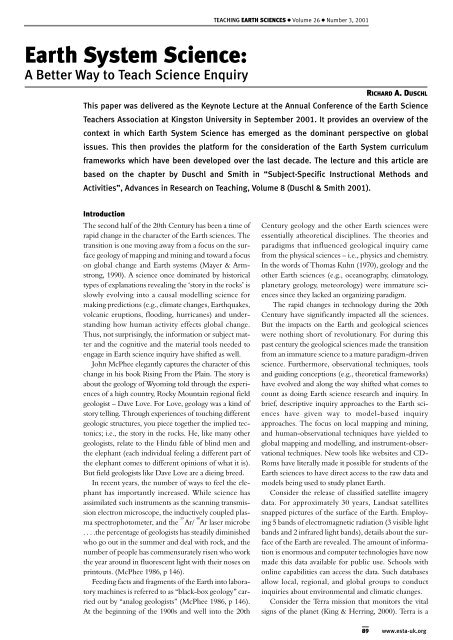teaching - Earth Science Teachers' Association
teaching - Earth Science Teachers' Association
teaching - Earth Science Teachers' Association
You also want an ePaper? Increase the reach of your titles
YUMPU automatically turns print PDFs into web optimized ePapers that Google loves.
TEACHING EARTH SCIENCES ● Volume 26 ● Number 3, 2001<br />
<strong>Earth</strong> System <strong>Science</strong>:<br />
A Better Way to Teach <strong>Science</strong> Enquiry<br />
RICHARD A. DUSCHL<br />
This paper was delivered as the Keynote Lecture at the Annual Conference of the <strong>Earth</strong> <strong>Science</strong><br />
Teachers <strong>Association</strong> at Kingston University in September 2001. It provides an overview of the<br />
context in which <strong>Earth</strong> System <strong>Science</strong> has emerged as the dominant perspective on global<br />
issues. This then provides the platform for the consideration of the <strong>Earth</strong> System curriculum<br />
frameworks which have been developed over the last decade. The lecture and this article are<br />
based on the chapter by Duschl and Smith in “Subject-Specific Instructional Methods and<br />
Activities”, Advances in Research on Teaching, Volume 8 (Duschl & Smith 2001).<br />
Introduction<br />
The second half of the 20th Century has been a time of<br />
rapid change in the character of the <strong>Earth</strong> sciences. The<br />
transition is one moving away from a focus on the surface<br />
geology of mapping and mining and toward a focus<br />
on global change and <strong>Earth</strong> systems (Mayer & Armstrong,<br />
1990). A science once dominated by historical<br />
types of explanations revealing the ‘story in the rocks’ is<br />
slowly evolving into a causal modelling science for<br />
making predictions (e.g., climate changes, <strong>Earth</strong>quakes,<br />
volcanic eruptions, flooding, hurricanes) and understanding<br />
how human activity effects global change.<br />
Thus, not surprisingly, the information or subject matter<br />
and the cognitive and the material tools needed to<br />
engage in <strong>Earth</strong> science inquiry have shifted as well.<br />
John McPhee elegantly captures the character of this<br />
change in his book Rising From the Plain. The story is<br />
about the geology of Wyoming told through the experiences<br />
of a high country, Rocky Mountain regional field<br />
geologist – Dave Love. For Love, geology was a kind of<br />
story telling. Through experiences of touching different<br />
geologic structures, you piece together the implied tectonics;<br />
i.e., the story in the rocks. He, like many other<br />
geologists, relate to the Hindu fable of blind men and<br />
the elephant (each individual feeling a different part of<br />
the elephant comes to different opinions of what it is).<br />
But field geologists like Dave Love are a dieing breed.<br />
In recent years, the number of ways to feel the elephant<br />
has importantly increased. While science has<br />
assimilated such instruments as the scanning transmission<br />
electron microscope, the inductively coupled plasma<br />
spectrophotometer, and the 39 Ar/ 40 Ar laser microbe<br />
. . . .the percentage of geologists has steadily diminished<br />
who go out in the summer and deal with rock, and the<br />
number of people has commensurately risen who work<br />
the year around in fluorescent light with their noses on<br />
printouts. (McPhee 1986, p 146).<br />
Feeding facts and fragments of the <strong>Earth</strong> into laboratory<br />
machines is referred to as “black-box geology” carried<br />
out by “analog geologists” (McPhee 1986, p 146).<br />
At the beginning of the 1900s and well into the 20th<br />
Century geology and the other <strong>Earth</strong> sciences were<br />
essentially atheoretical disciplines. The theories and<br />
paradigms that influenced geological inquiry came<br />
from the physical sciences – i.e., physics and chemistry.<br />
In the words of Thomas Kuhn (1970), geology and the<br />
other <strong>Earth</strong> sciences (e.g., oceanography, climatology,<br />
planetary geology, meteorology) were immature sciences<br />
since they lacked an organizing paradigm.<br />
The rapid changes in technology during the 20th<br />
Century have significantly impacted all the sciences.<br />
But the impacts on the <strong>Earth</strong> and geological sciences<br />
were nothing short of revolutionary. For during this<br />
past century the geological sciences made the transition<br />
from an immature science to a mature paradigm-driven<br />
science. Furthermore, observational techniques, tools<br />
and guiding conceptions (e.g., theoretical frameworks)<br />
have evolved and along the way shifted what comes to<br />
count as doing <strong>Earth</strong> science research and inquiry. In<br />
brief, descriptive inquiry approaches to the <strong>Earth</strong> sciences<br />
have given way to model-based inquiry<br />
approaches. The focus on local mapping and mining,<br />
and human-observational techniques have yielded to<br />
global mapping and modelling, and instrument-observational<br />
techniques. New tools like websites and CD-<br />
Roms have literally made it possible for students of the<br />
<strong>Earth</strong> sciences to have direct access to the raw data and<br />
models being used to study planet <strong>Earth</strong>.<br />
Consider the release of classified satellite imagery<br />
data. For approximately 30 years, Landsat satellites<br />
snapped pictures of the surface of the <strong>Earth</strong>. Employing<br />
5 bands of electromagnetic radiation (3 visible light<br />
bands and 2 infrared light bands), details about the surface<br />
of the <strong>Earth</strong> are revealed. The amount of information<br />
is enormous and computer technologies have now<br />
made this data available for public use. Schools with<br />
online capabilities can access the data. Such databases<br />
allow local, regional, and global groups to conduct<br />
inquiries about environmental and climatic changes.<br />
Consider the Terra mission that monitors the vital<br />
signs of the planet (King & Herring, 2000). Terra is a<br />
89 www.esta-uk.org

















